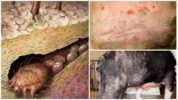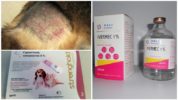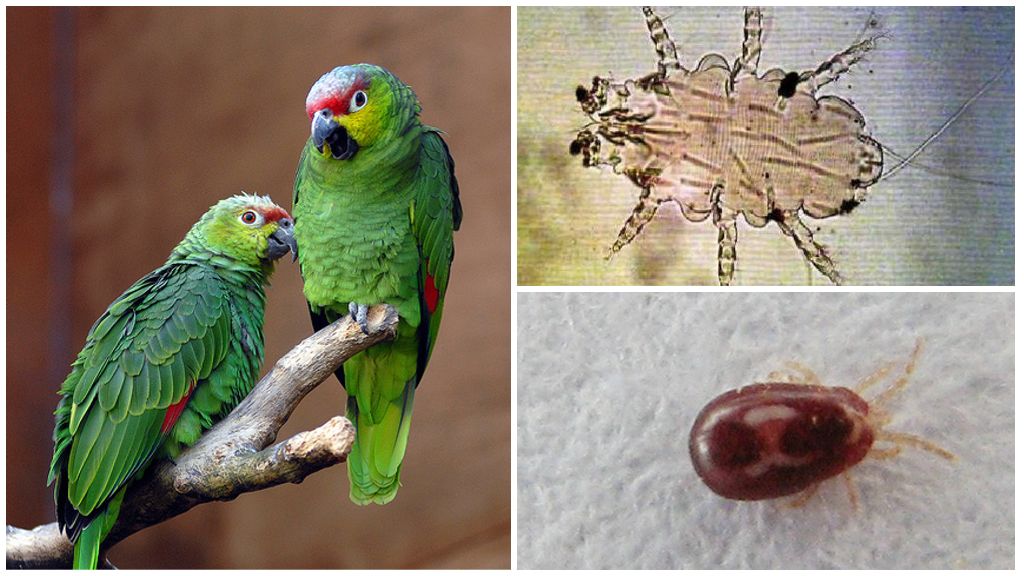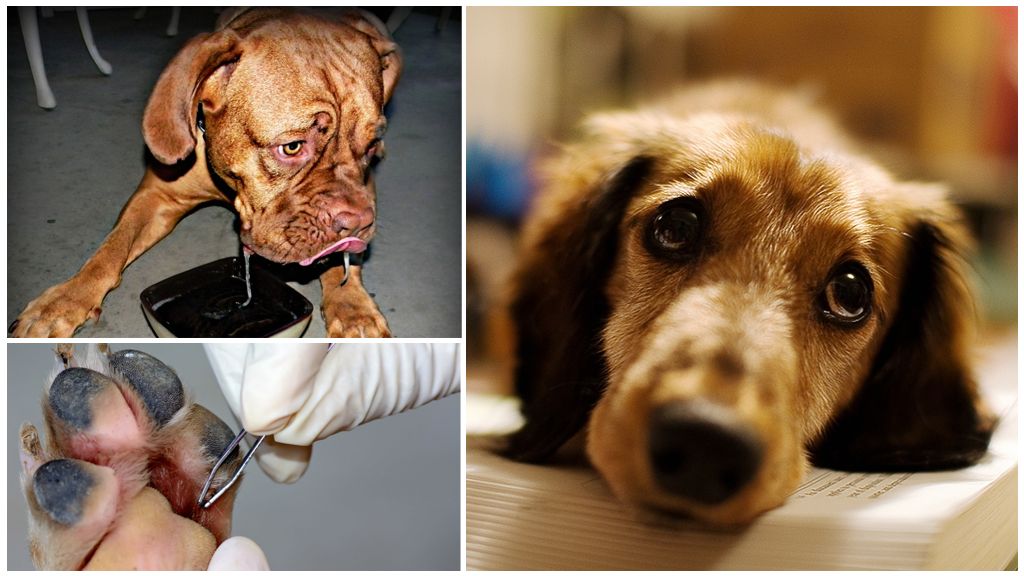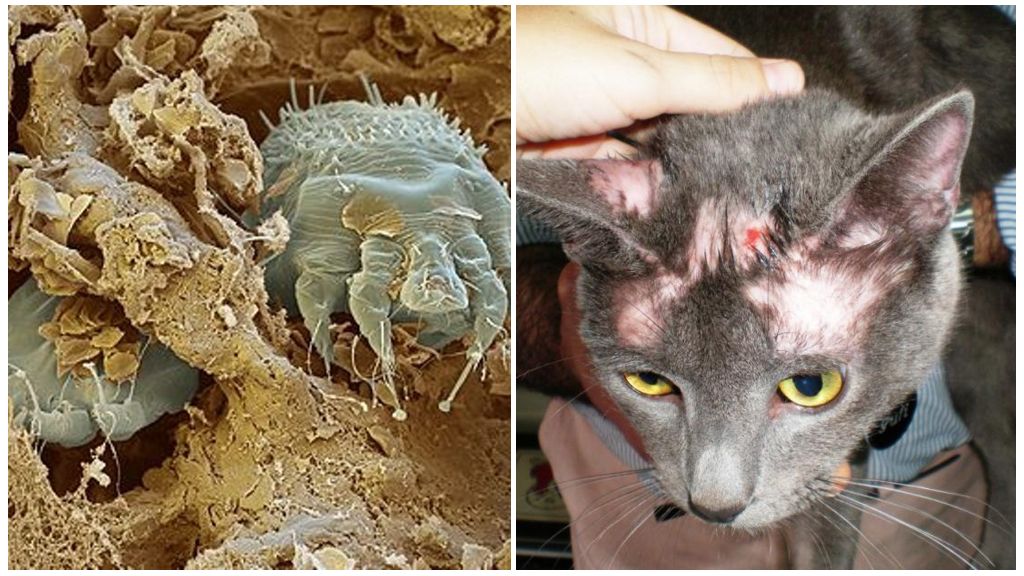- Sarcoptoid ticks in dogs
- Symptoms of the scabies mite
- Scabies Mite Control Methods
- Folk remedies against scabies mite
Pets, like other representatives of the fauna, constantly encounter external pests. A caring and attentive owner can timely identify and neutralize the source of a dangerous disease. Itch mite in dogs is a fairly common occurrence, causing great trouble to the animal. It requires immediate treatment, which will avoid negative consequences for the health of both the dog and the person.
General characteristics of parasites
The causative agents of scabies in dogs are microscopic mites from the Sarcoptidae family. They are the so-called scabies itching Sarcoptes scabiei and Notoedres cati. They parasitize on all carnivores.
Important!
The defeat of a person is temporary. This is due to the fact that ticks are not able to exist for a long time without their host, which provides favorable conditions for the reproduction and growth of larvae.
Subcutaneous ticks in dogs have a fairly simple structure and are endowed only with smell and touch. These sensory organs allow pests to choose the “right” victim. The parasite has a powerful mouth biting-sucking type. The itch mite is very small in size from 0.2 to 0.5 mm, which makes it impossible to see the pest with the naked eye.
The main role in the spread of a dangerous disease belongs to females, since males die after fertilization. Female individuals move under the skin of the dog at a speed of 0.5 - 2 mm per day, gnawing the winding tunnels in which they lay their eggs. The length of the strokes can reach approximately 4 cm.
In appearance, ticks resemble a small turtle. The external chitinous coating has numerous bristles and protrusions of a certain shape. 4 pairs of five-membered legs end with small suckers, providing the parasite only moves forward. Spikes on the front legs allow the pest to penetrate the stratum corneum of the epidermis. Photos of scabies mites provide an opportunity to clearly see a dangerous dog pest.
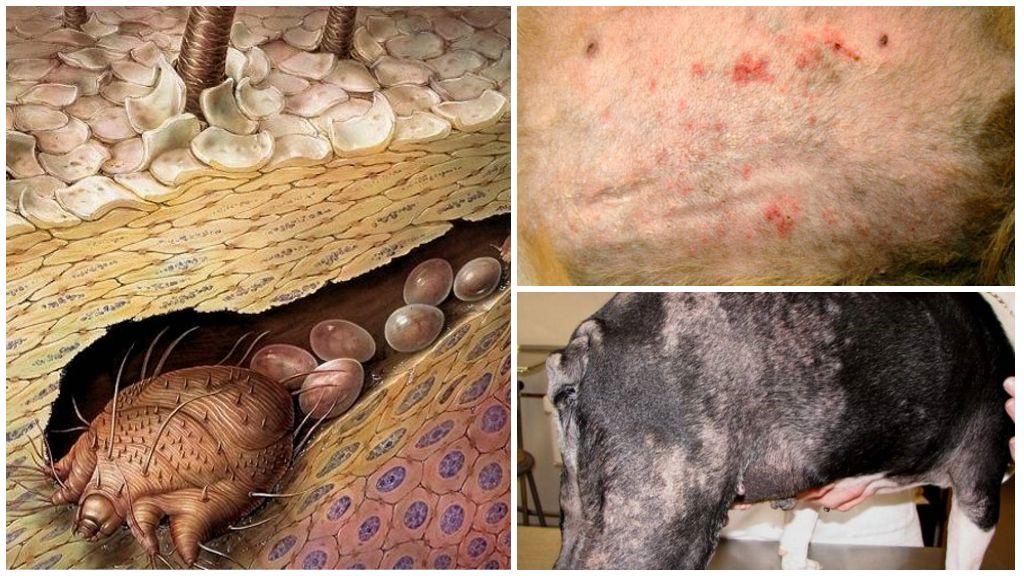
The itch breeds rapidly. The peak activity of the process falls in the autumn-winter period. Female ticks live for about a month, laying up to 150 oval eggs in gnawed cavities of the dog’s skin during this period. Having completed the laying of eggs, it comes to the surface, making new moves for air access to future offspring. Larvae reaching 0.1-0.15 mm in size appear on 3-7 days, unlike adults, they have only 3 pairs of legs. The full cycle of the development of the insect is 15-21 days and includes 4 stages: egg, protonymph, teleonymph and adult. The parasite feeds on lymph and tissue fluid.
On a note!
Sarcoptoid ticks in dogs, which are the causative agents of scabies, are transmitted from the affected animal to a healthy arthropod mainly by contact. However, it is possible to become infected with parasites and through household items, shoes, clothes, and a walking area.
Depending on the type of tick found on the dog’s body, a non-seasonal infectious disease is called sarcoptosis or notothedrosis. An accurate diagnosis is possible only with the help of a laboratory study of scraping from the affected area of the skin. The treatment for these forms of scabies is almost the same.
Symptoms and stages of development of scabies in dogs
Aggressive external parasites, which include scabies mites, do not leave their host “voluntarily”. Timely detection of pests and effective treatment will save the dog from the harmful effects of the disease. The main symptom of scabies is severe itching. The animal constantly itches, becomes nervous, loses its appetite, immunity decreases. The toxic waste products of ticks enter the bloodstream, which leads to a deterioration in the general condition of the pet. Combed areas of the skin become additional sources of infection. A progressive disease can lead to serious disorders in the respiratory and cardiovascular systems, and if untreated scabies is treated, it can be fatal.
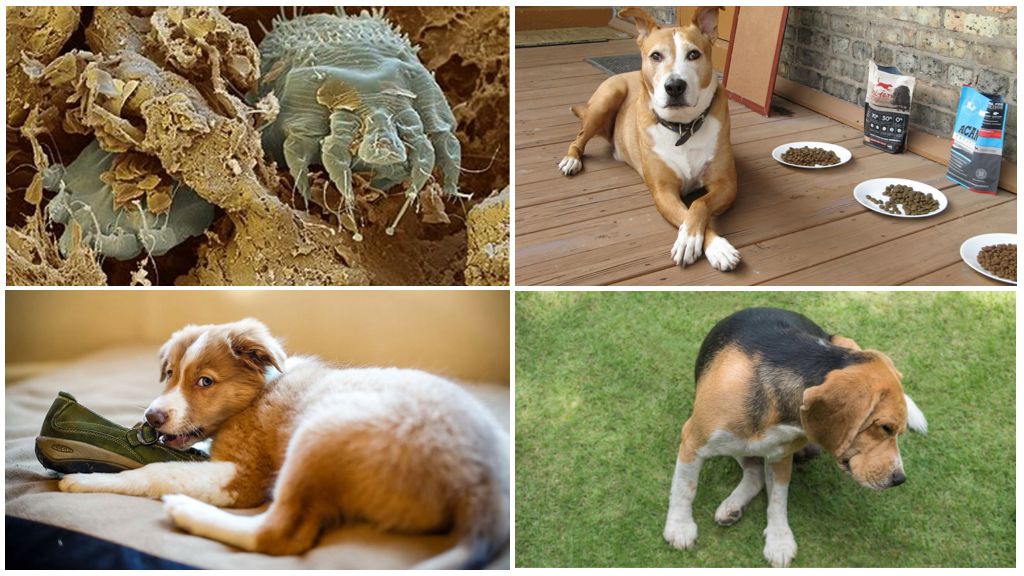
Sarcoptosis and notoedrosis differ in the location of foci of localization of the disease.
Important!
Scabies mites give preference to places on the dog’s body with thin and thin hair, as well as with delicate sensitive skin.
The presence of sarcoptosis is indicated by redness and irritation of the skin in the head, chest, tail root, and abdominal cavity. In dogs, foci may appear on the foreskin. The causative agents of notedrosis primarily occupy the dog’s head, affecting the back of the nose, forehead, outer surface of the ears, as well as delicate skin above the eyes. Next, the ticks move to the front and hind limbs.
On a note!
Dry air and heat contribute to itching, cold - brings some relief to the dog.
The first signs of the disease are detected approximately 14 days after infection. It develops in stages and has the following characteristic symptoms:
- Dog nervousness and anxiety
- the affected skin turns red, itches severely, hair loss is observed;
- ulcers, papules, fistulas, deep infected wounds, possibly skin bleeding;
- extensive growth of affected areas along the body of the dog, the formation of scabs and disruption of heat transfer processes;
- keratinization of epidermal particles, which externally resemble large dandruff.
The presence of any of these symptoms in the animal should alert the host. You should immediately contact your veterinarian and, with the help of a laboratory test, confirm or deny the presence of scabies in the dog.
Methods for controlling a dangerous disease
Timely and correctly selected treatment for scabies mites is the key to the health of a pet. The doctor, based on the results of the tests, selects effective antiparasitic drugs. The initial stage of the disease does not require long-term treatment, in contrast to the neglected form.
On a note!
The dog must not be bathed before being examined by a specialist. The procedure will reduce the likelihood of detection of the pathogen in the scraping.
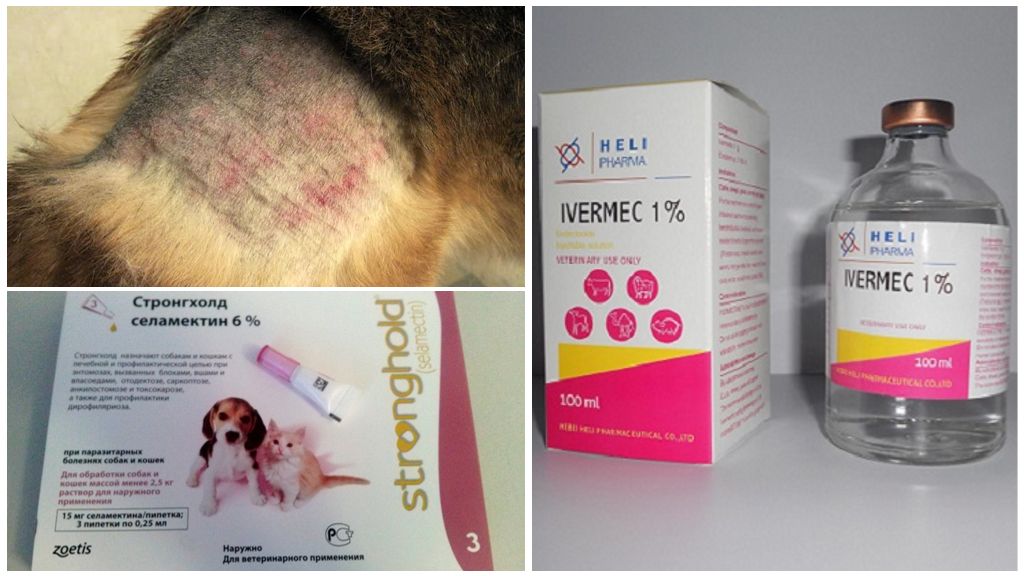
Therapy of scabies in dogs involves an integrated approach to solving the problem. The course of treatment may include the following sequence of actions:
- Removing wool from the affected areas of the skin.
- Water procedures using acaricidal drugs according to the scheme developed by the doctor. The use of shampoos with birch tar and chlorhexidine has a positive effect.
- Local treatment of animal skin with antiparasitic solutions, sprays, drops of stronghold (price varies from 890 to 1300 rubles), Advantage (estimated cost 1800 rubles), Frontline Combo (approximately 800 rubles) and other drugs.
- Injection with drugs containing ivermectin.The dosage and number of injections is determined by the veterinarian depending on the severity of the disease, breed and individual characteristics of a particular dog.
Treatment of scabies at home can be carried out with the help of an effective drug of domestic production - Amidel gel NEO. It consists of cyfluthrin, lidocaine, glycerin and other auxiliary components that provide a high therapeutic effect from the use of the combined drug. The gel has proven itself not only in the initial stages of the disease, but also in combination with ivermectin injections is used in difficult situations. The democratic price is 170-190 rubles. for a 10-gram syringe dispenser makes the drug available to consumers.
Folk remedies
Many dog owners try to cure their pet of scabies using folk methods. It should be noted that this process is quite lengthy and does not always give the expected positive result.
On a note!
A good alternative medicine, judging by the reviews, which helps in the fight against sarcoid mites in dogs, is a weak solution of lysol. However, it should be borne in mind that the drug can adversely affect the general condition of the pet.
To protect the animal from the attack of pests, you can use decoctions of herbs, essential oils, tar soap.
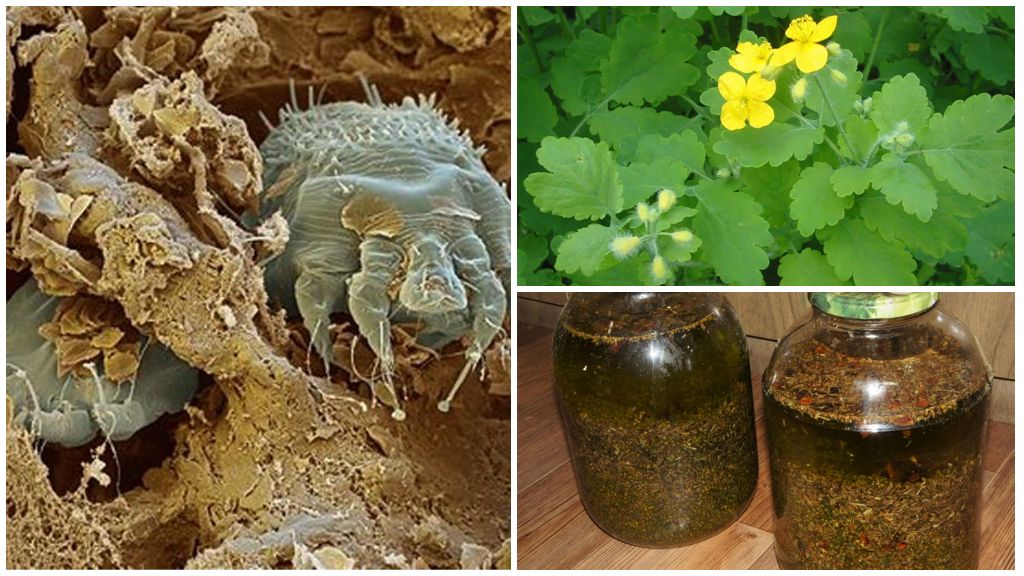
You can also use ointments and tinctures for treatment:
- Give a drink every 2-3 hours to the dog a decoction made from honey and wormwood. Serving is half a cup at a time.
- Ointment. For its preparation, it is necessary to fill the roots of the celandine with refined sunflower oil. Put the pan on a small fire and simmer the resulting composition for 2-3 hours. Strain the infusion, add sour cream and rub the ointment into the skin of the pet. Ears and nose can be buried.
- Mask. Grate sour apples with elecampane roots or juniper berries. The resulting mixture is applied to the affected areas of the skin of the animal.
It is also recommended 1-2 times a week to carry out procedures with birch tar or tar soap.
Preventive actions
Any disease is easier to prevent than to cure - it is an axiom, time-tested. So that the dog does not become infected with subcutaneous ticks, it is necessary to adhere to elementary rules:
- Avoid contact with stray animals;
- while walking use special protective collar;
- after visiting the street, treat the dog’s things with antiparasitic sprays from fleas and ticks;
- Visit your veterinarian regularly for an examination.
If it was not possible to avoid infection with sarcoid mites, then you must strictly follow all the doctor’s instructions and take precautions to protect yourself, as well as all family members and other pets.
Reviews
The doctor diagnosed scabies in our dog. For treatment, I recommended to use Stronghold Drops. They strictly followed the instructions of the veterinarian and quickly got rid of ticks. Great drug.
Inga, Kaliningrad
They treated their dog Amidel with NEO gel. One syringe was enough for the complete destruction of ticks. They got rid of scabies quickly and without complications. Recomend for everybody.
Konstantin, Moscow
